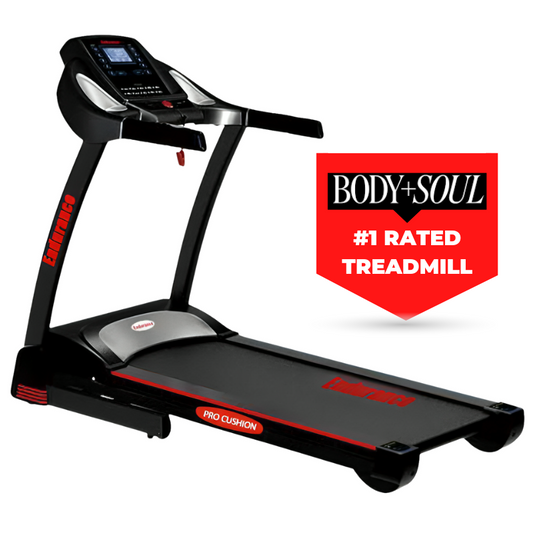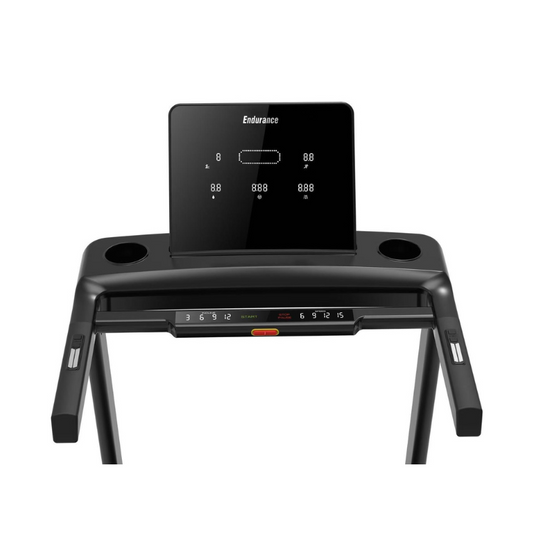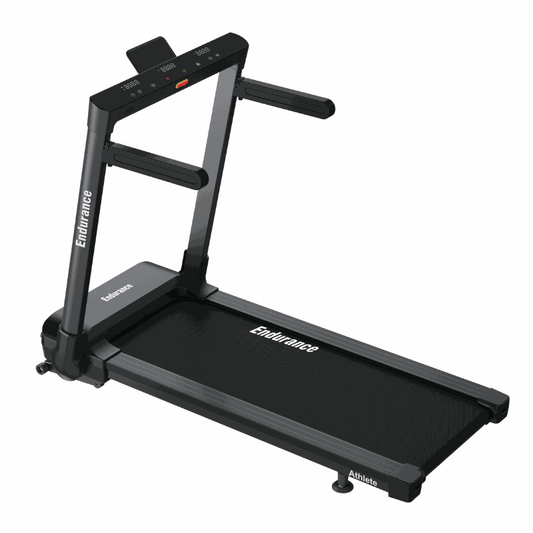Collection: Folding Treadmills
Folding treadmills are space-saving workout machines designed for home gyms and apartments in Australia.
These folding treadmills make it super simple to store them away after use, and they adapt easily to small apartments or cramped areas.
Other features models often include built-in wheels, easy-lift frames and digital screens.
For people living in apartments or shared homes, folding treadmills allow you to keep moving while not permanently sacrificing living space.
The second part offers additional advice for choosing and using these machines.
What is a Folding Treadmill?
A folding treadmill is specifically engineered for space-saving. This makes it an excellent option for apartments or homes where space is at a premium.
When it’s time to put the treadmill away until next time, the deck folds up so you can store it under a bed or in a closet. Thanks to wheels located on the base, you can easily roll it from the living room to a guest room.
Typically, this best folding treadmill comes with a more compact running belt, roughly 20 x 60 inches, which is ideal for most walkers and joggers. They range from $300 to $6,000, so there is something for the frugal as well as the wealthy.
Though users complain about more wobbliness than with non-foldable treadmills, most of the newer generation models are pretty stable. Some additional maintenance, such as regularly oiling the shock tube, goes a long way towards maintaining smooth operation.
Why Choose a Folding Treadmill?
If you need a convenient cardio workout, but are tight on space, a folding treadmill is a perfect fit for you. These treadmills are easy to fold up vertically, reducing their footprint by 50% or more.
Those living in apartments or shared accommodation in popular cities such as Sydney or Melbourne would benefit from this. Nearly all models feature built-in wheels and an easy fold latch.
This function means you can simply move them from the lounge to a spare bedroom. Many are quite lightweight—only 25 kilograms—making them easy to move.
They fit under desks, allowing you to walk while you work. One thing to note: folding treadmills can be a bit less steady than fixed ones, but the trade-off is space and ease.
When folded, they can even reduce footprint by up to 40 percent, so storing them away is a breeze.
Key Features to Check Before Buying
Quality folding treadmills can be found at all levels of specs that are game changers for residential users. Size matters when it comes to the running deck! The right size A 20 x 60 inch working surface is ideal, though an 18 x 40 inch deck can seem tight.
Speed limits typically range from 10 to 15 miles per hour, though some are higher for sprint workouts. Incline features range from a light 3% to a steep 40% for hill workouts. Weight limits usually max out at 300 or 350 pounds.
Deck feel is another important aspect to consider. The softness or firmness of the deck affects how comfortable a rider feels. When folded, certain models are able to compress down to 40 percent of their size.
Do look at the overall weight, as there are some treadmills only 55 pounds. Additional amenities such as touchscreens and Bluetooth capabilities are doing wonders.
Folding vs. Standard Treadmills Compared
Folding treadmills are a great choice if your home doesn’t have a lot of available space, because you can easily store them when not in use. They’re easier to move around. Most of them have wheels, allowing you to roll them from living room to guest room with minimal effort.
Standard treadmills are heavier and are more likely to remain in one place. This extra stability can be convenient if you don’t expect to move them around very much. You’ll notice that folding treadmills tend to have lighter frames, which can make them wobblier, particularly at high speeds.
Standard treadmills are very sturdy and tend to be more durable, but they do take up more space. Folding models require slightly more maintenance, especially near the folding mechanisms and the motor.
Both types have a large price range, so consider space, usage, and maintenance requirements.
Fitting One in Your Space
Folding treadmills are ideal for Aussie homes where floorspace is often at a premium. What’s more, many models compact down by almost 40 percent when folded. This is the same reason they’re easy to shove in a corner, shove in a cupboard, or even move to another room.
Some even fold down to as small as 12 x 31.5 x 64.75 inches, making storing it a less daunting brain-fry. Many feature wheels, making it easy to roll them in and out as needed. Compared to platform treadmills, folding models are lighter, but often feel less robust.
The deck, typically 20 by 60 inches at this point, remains spacious enough to accommodate the majority of run forms. These treadmills are great options for renters, flat-dwellers, and those simply looking to manage space.
Simple Maintenance for Longevity
Keep this simple maintenance onboard and it will go a long way with folding treadmills. Cleaning the belt or deck with a damp cloth once a week is an easy yet impactful task. It’s the simple maintenance that makes long-lasting equipment run well.
Purchase a vacuum with a crevice tool to remove dust and grit from difficult-to-reach spots. This prevents unwanted wear and tear while helping your machine operate at peak performance. Removing small rocks and checking for loose bolts or screws every once in a while can prevent minor issues from becoming major repairs down the line.
Lubricating the treadmill belt every three months or every 150 miles reduces friction and prevents premature wear. By performing a complete inspection at least once a year, you’ll extend the life of your treadmill.
Following these habits can reduce breakdowns by as much as 40% and ensure you’re getting the most out of your machine.
Essential Safety Features to Look For
Whether you’re shopping for the best folding treadmill for seniors or an adult, safety should be your number one priority. A generous belt of at least 500mm gives you extra leeway for your foot. This added flexibility goes a long way in reducing slips, particularly when fatigue sets in.
Essential motor size features are also crucial. The size of the motor plays an important role in the treadmill's performance. For walking, a 1.5–2 CHP motor is more than enough. Jogging requires a little more oomph—2.5 to 3 CHP.
For runners, aim for at least 3.5 CHP. Ensure the treadmill is rated for at least an extra 10–20kg above user weight. Automatic belt lubrication reduces maintenance and ensures smooth operation.
Additionally, have enough room behind the treadmill to catch yourself if you fall. Thereafter, you’ll want to replace the belt every few years, depending on use.
Finding Your Perfect Folding Match
The right folding treadmill really depends on how you plan to use it and the space you have available.
CONVENIENCE
Manufactured from durable and stretchy materials, a running belt with at least 4 ft of adjustable length ensures every step is well-supported. Larger folding treadmills can easily weigh upwards of 249 pounds.
You can deftly fold them with one hand, and they store beautifully in a flat or garage. Runners who value durability on the road or trail want high speeds (up to 15 kilometres per hour) and a long deck to fit their huge strides.
Walkers and joggers might prefer lighter, quieter models. Deck size, build, and sound make a difference in comfort and ease. Great programming and warranty protect your investment.
-

 Sold out
Sold outEndurance SPT Treadmill
Regular price $1,149.00 AUDRegular priceUnit price / per$1,699.00 AUDSale price $1,149.00 AUDSold out -

 Sold out
Sold outEndurance HPT Treadmill
Regular price $2,499.00 AUDRegular priceUnit price / per$2,999.00 AUDSale price $2,499.00 AUDSold out -

 Sold out
Sold outEndurance Athlete Treadmill
Regular price $1,299.00 AUDRegular priceUnit price / per$1,899.00 AUDSale price $1,299.00 AUDSold out






